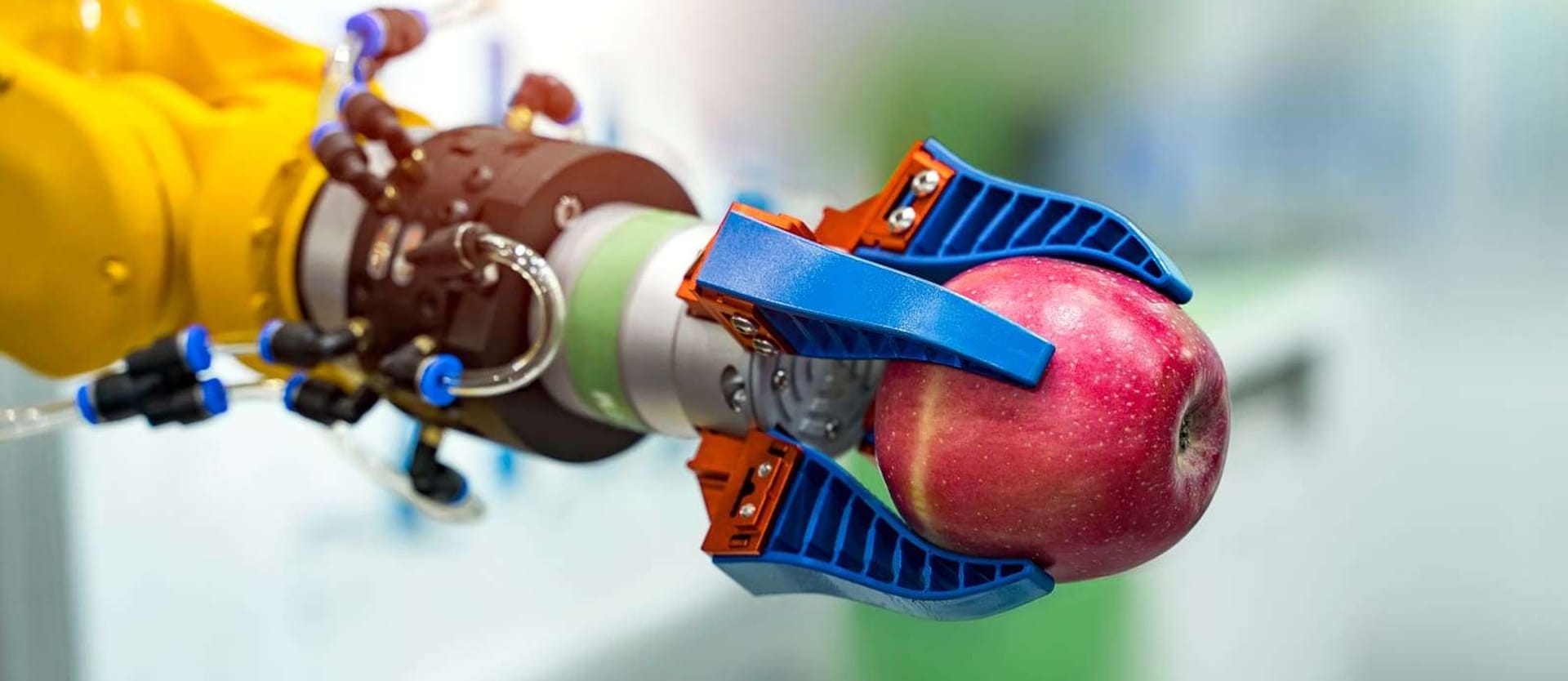When contemplating automation, we’re inclined to think about industrial processes and machinery. While a good example, remember that automation solves not only blue-collar labor issues, it also solves the white-collar variety. The last ten years saw the emergence of new technology aimed at automating clerical processes.
The subset of automation concerning specifically business processes is called robotic process automation or RPA. The concept of RPA is not new, and it has already become a standard for optimizing internal processes in enterprises. However, it only starts gaining real power with the help of artificial intelligence (AI) and machine learning (ML). The fusion of AI technologies and RPA is known as Intelligent or Cognitive Automation.
In this article, we’re going to explore what robotic process automation is, how it works in the classic sense, and how AI technologies are or can be used in it. Distinguishing RPA problems, we will look at real cases to demonstrate how AI or ML are solving problems and examine industry cases of cognitive automation technologies.
The subset of automation concerning specifically business processes is called robotic process automation or RPA. The concept of RPA is not new, and it has already become a standard for optimizing internal processes in enterprises. However, it only starts gaining real power with the help of artificial intelligence (AI) and machine learning (ML). The fusion of AI technologies and RPA is known as Intelligent or Cognitive Automation.
In this article, we’re going to explore what robotic process automation is, how it works in the classic sense, and how AI technologies are or can be used in it. Distinguishing RPA problems, we will look at real cases to demonstrate how AI or ML are solving problems and examine industry cases of cognitive automation technologies.
What is standard Robotic Process Automation?
Robotic process automation is one of the most basic ways to automate simple rule-based processes. Its predecessor should be considered screen-scraping and repeating user actions, which is still applied in QA automation. But, the main goal of RPA is to reduce human involvement in labor-intensive tasks that don’t require cognitive effort like filling out forms or making calculations in spreadsheets.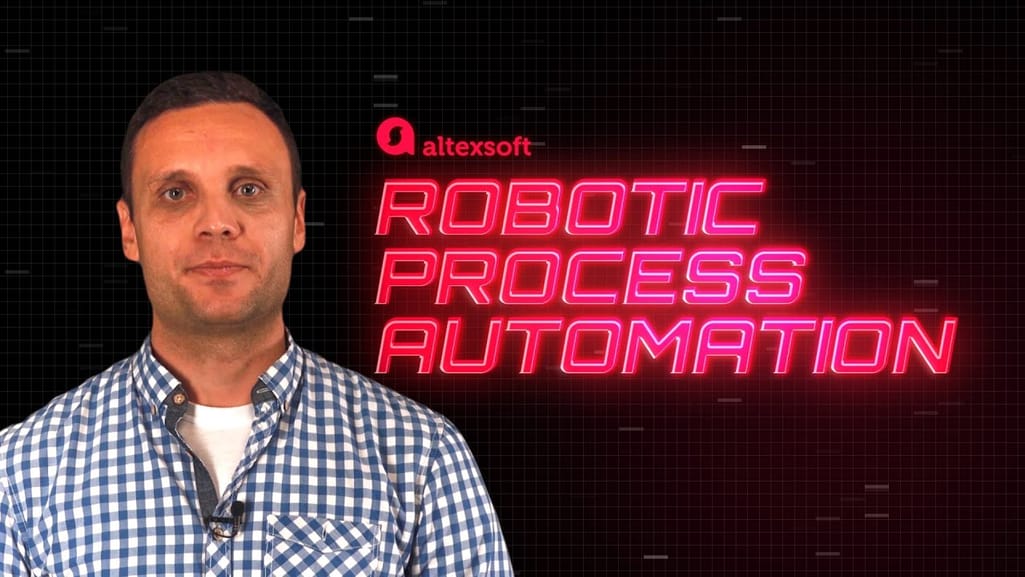

RPA explained
RPA utilizes software programs called bots (think robots). Bots are the mainstays of RPA, its virtual workforce. A bot represents a programmable or self-programming unit that can interact with different applications in the system to perform various processes. The key element of any bot in robotic automation is that they are able to work only within a user interface (UI), not with the machine (or system) itself.Here’s an example to explain how RPA works:
- Your employee has to manually enter data in a form, be it an invoice, request order, purchase order, transaction details, etc.
- This is done via Microsoft Office tools, and the data is either stored in spreadsheets, ERP, or CRM.
- The bot can be programmed to follow the same patterns as real users do, which requires it to know where the UI elements are, and what the flow of the process is.
- Rules are hardcoded each time the process changes. Or the bot is screen scraping the process reproduced by the human agent.
- Using multiple bots, human operators can choose multiple repetitive activities and apply bots for them.
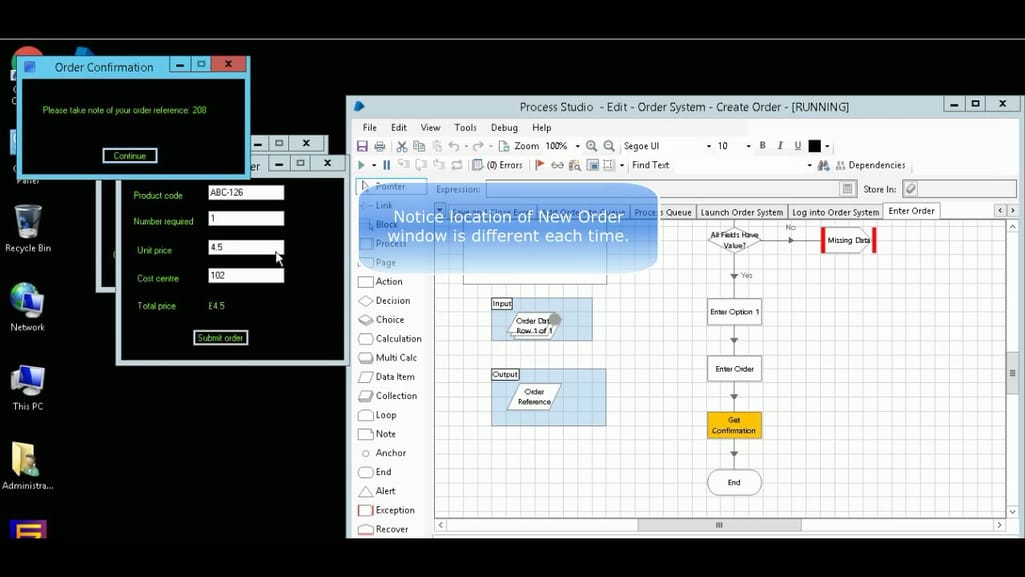

Blue Prism bot processing customer orders demo
Depending on the industry, a bot can have a list of prewritten tasks that it can handle. Bots are usually built and offered by vendors. So, integration tasks and configuration of the bots can be carried out by the vendor. For self-programmed bots, there is also a dedicated programming interface available, which is basically an IDE for bot programming. However, you can build and configure custom bots as well.
Automation Everywhere bot programming interface
Source: ui.vision
Bots can be installed on the user’s device in case it will work with sensitive data, or operate from a cloud as a SaaS solution. But for the simple utilization of screen scraping, RPA has become a standard way to automate white-collar processes and initiate digital transformation.Current RPA limitations
Bots are capable of performing all the tasks ascribed to them: click, type, navigate, copy/paste/delete, open applications, visit websites, etc., all sufficient for straightforward tasks they were intended to work on. Whenever something changes in the process, a bot will make a mistake, or stop working, because these changes weren’t included in the rules. So, in its classic form, RPA does have certain limitations:Need human involvement. Bots may require nearly no coding knowledge to configure and accomplish some simple task. Partially, that’s possible because of the screen recording and scraping that allows bots to learn what a real user clicks/opens/drops by observing real employees doing that. However, it requires time, and humans to teach bots. For more complex tasks, there are no alternatives but to hardcode the process and rules.
No flexibility. Today RPA bots aren’t capable of responding to changes in the system without human interaction. Which means every time there is a slight change in the workflow or in the interface, the process should be interrupted and modified by the developer.
Being limited to prescribed rules, RPA can hardly be used for automating complex flows. So, with the advances in AI, robotic-automation-industry vendors start utilizing artificial intelligence technologies to boost RPA bots with the cognitive capabilities.
The next step in Robotic Process Automation: Cognitive Automation
Screen-scrapers were the root technology of robotic process automation, and it was unlike building artificial intelligence. While robotic automation concerns mimicking human activity via a user interface, artificial intelligence is aimed at mimicking human thought process.In a nutshell, AI is a broad concept of creating a machine able to solve narrow problems like humans do. As any person would, AI should learn the information/process first. Machine learning comes as a subset of AI that can solve problems by learning from data. As artificial intelligence technologies become more accessible, RPA is facing opportunities to overcome current limitations.
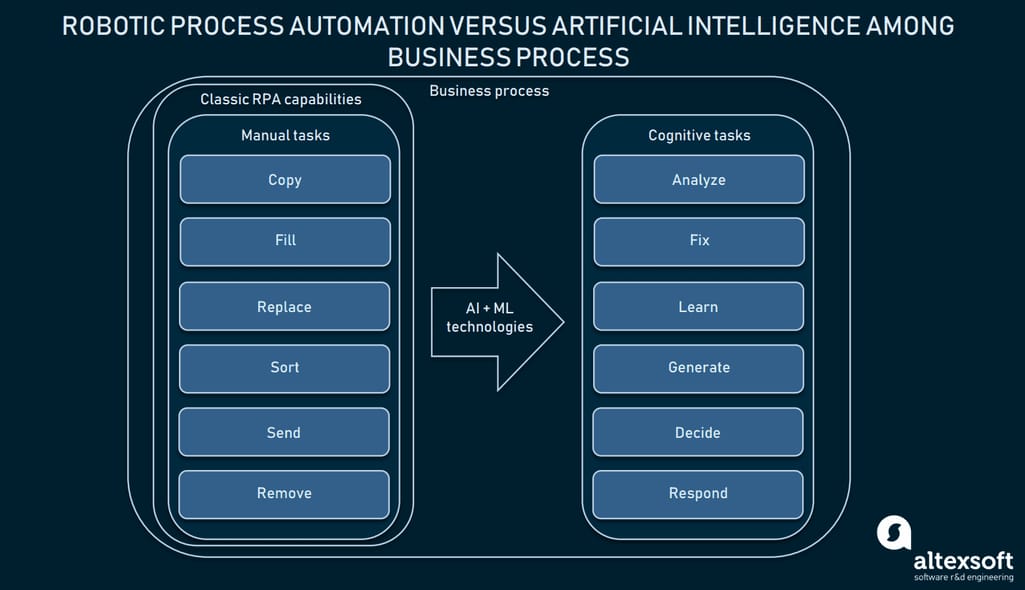
RPA capabilities versus AI in the business process
AI is taking its first steps into RPA, but many vendors already claim to have bots fueled by machine learning algorithms. To divide the sci-fi kind of stuff from what AI really is, you can watch our video explaining the core definition of artificial intelligence and its subsets:

Definition and examples of artificial intelligence explanation
So, RPA represents a classic example of a rule-based system. This means the bot is capable of doing only those things it was directed to do. While it’s enough to complete tasks that have strict rules or unchanging conditions, AI and machine learning specifically can arm bots with cognitive capabilities and even decision-making. Currently, there are four major branches of ML-based RPA (or rather RPA augmented with ML technologies):- Human language processing
- Computer vision
- RPA analysis and automatic orchestration
- Error handling
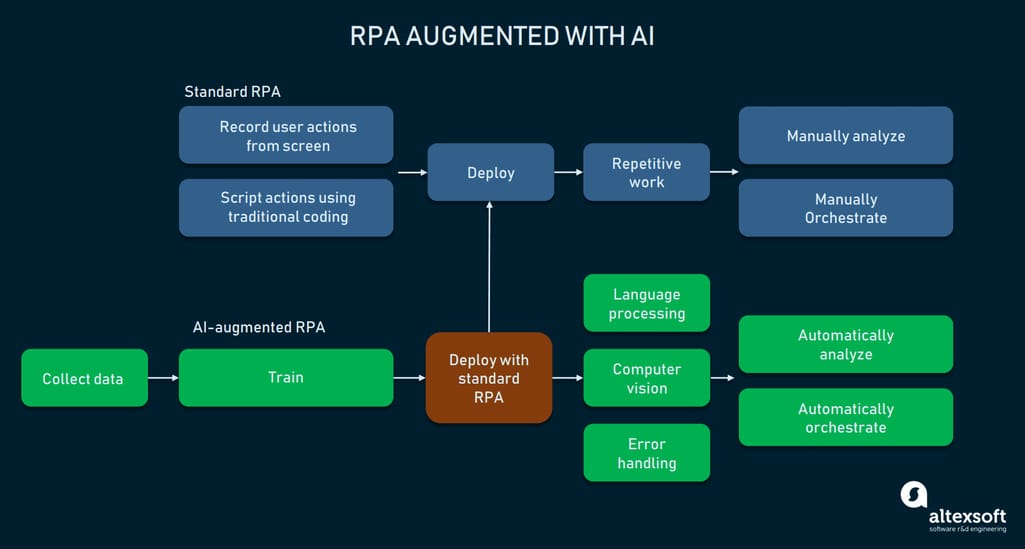
Standard RPA implementation can be augmented with additional AI-driven capabilities
So let’s break those use-cases down and analyze which AI technologies can be used to make it possible.Human language processing for virtual assistants and voice transcription
RPA is mostly utilized to automate back-office processes. However, there a lot of routine tasks that still require humans. One of the opportunities in this field is implementation of human language processing technologies to enable bots to understand human speech or text accurately. Natural language processing (NLP) is a technology that helps do this. Some of the most advanced chatbots utilize NLP to communicate with humans, transcribe speech, analyze it, and even respond. So, what are the opportunities for NLP use?Phone call transcription. With NLP, it’s possible to automate customer-support processes or enable machines to use human speech as an input. As an example, you can read a case-study by Cognizant. They provided a smart bot to an insurance company to automate the notice-of-loss process with a bot transcribing human speech from phone calls.
Virtual assistants. Another common use case for that is building chatbots capable of understanding customer service requests and providing automatic responses.
Report generation. McKinsey suggests applying text generation techniques to automatically create reports. As rule-based RPA bots can gather information across multiple sources, an NLP-based algorithm can be trained on standard reports to automatically generate them using the data provided.
Computer vision to analyze texts, images, and interfaces
Recognizing written characters requires machines to “read” each symbol and learn how to understand them in combination. But visual information like photos has even more dimensions to analyze, so different techniques are used to teach machines to analyze images.Computer vision is aimed at teaching a machine to see a real-world object and generate an interpretation of it: name physical properties or classify objects it sees. You can find the implementations of computer vision in self-driving cars or mobile apps that can measure the object dimensions via a camera and even analyze what they see. Using computer vision in RPA opens up capabilities to automate back-office operations or manual labor.
Written text recognition. For instance, computer vision can be used to convert written text in documents into its digital copy to be further processed by a standard RPA system. Or this may be a standalone interpretation to digitize paper-based documentation.
Image analysis. A lot of machinery maintenance work depends on analyzing visual information. By sending the images of machinery to an algorithm, a maintenance department will be able to receive an initial visual analysis before human involvement. This can also be applied in the insurance industry to support claims assessment. For instance, an image of a damaged car can provide an initial estimation of financial coverage.
Interface analysis. Since traditional RPA – that works with interfaces – can’t deal with interface changes, ML-based systems can help accommodate for minor interface alterations and keep a bot working. This also means that an ML-based system can be trained to recognize standard interface content, like texts, forms, and buttons to reduce human involvement in preparing these bots for production use.
RPA analytics and automatic orchestration
This is the most complex application field today, as it requires heavy investments into machine learning research and ultimately entails designing decision-making systems that can support human judgments.Bots performance analysis. If RPA bots are deployed at scale and perform hundreds of manual tasks, finding bottlenecks and opportunities for improvement becomes an intricate analytical task. By using historical and current data, it’s possible to define anomalies or causes of bottlenecks to further optimize bot performance.
Automatic orchestration. Bots rarely used as a single unit. Most often there are hundreds of them, which raises the question of centralized control. So in RPA, orchestration dashboards are used. Orchestration tools are the command dashboards used to manage the activity of multiple bots, configure them, change access levels, open up data sources, etc. Orchestration tools are also used to deploy new bots, scale the volume/quantity, or manage unexpected changes. These tools can be delivered as a cloud-based application or integrated into the existing system. For example, look at the UiPath orchestrator to see what an RPA dashboard look like.
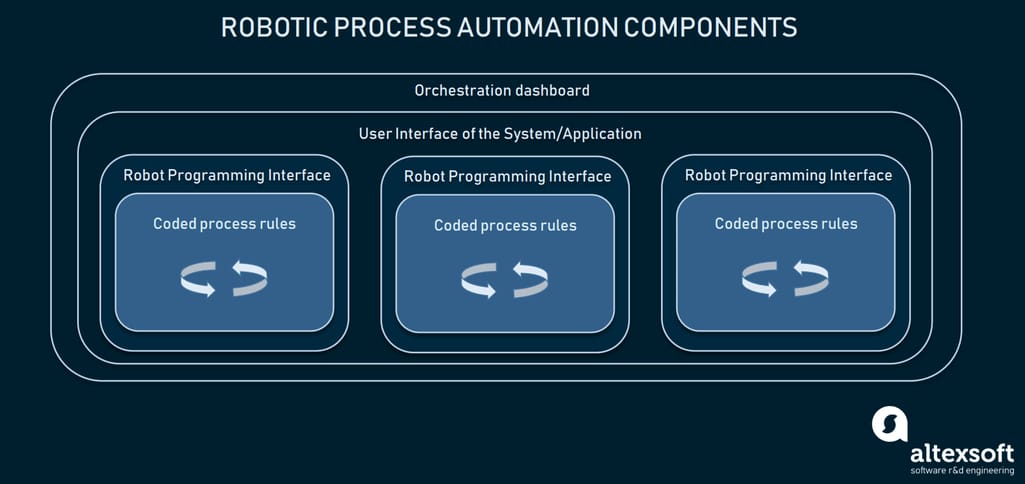
Components of RPA system
While data analytics will surely be viewed by human agents, there are spheres that can be potentially carried by bots. For example, scaling the number of working bots or bot allocation are the optimization tasks that can be automated using ML algorithms.Human error handling
This use case is critical for heavily regulated industries, where employees must process large amounts of information, and comply with multiple state regulatory requirements when filling out forms or doing, say, account reconciliation. This remains a very error-prone process in insurance, facilities, finance, and others. It requires multiple levels of validation and, ultimately, time.A traditional problem with machine learning use in regulated industries is the lack of system interpretability. In a nutshell, the most advanced AI systems based on deep neural networks can be very precise in their actions but remain black boxes both for their creators and for regulating bodies. This lack of interpretability is a red flag for regulators. However, the AI-based systems can still be used for error handling as they can recognize potential mistakes and highlight them for their human counterparts.
For instance, in bank reconciliations, such systems can reveal duplicate entries, different data formats, data discrepancies, various human mistakes like placing commas, adding wrong character spacing, etc.
Some of these use cases have already seen their implementations, mostly via custom engineering. However, off-the-shelf RPA providers also claim to have ML-systems under the hood.
Key RPA providers that support ML-based bots
All the biggest RPA providers on the market, like UiPath, Automation Everywhere, and Blue Prism, offer closed-code solutions, which can be both an advantage and a disadvantage. With the closed code-base, you entrust the data you work with to the vendor, hoping that no critical error will harm the bot. There are also open-source players like Kantu, offering an alternative to the industry behemoths.Automation Anywhere revealed its IQ Bot as a part of Unattended RPA in 2019. The bot is capable of learning by observing human employees performing tasks. It’s armed with language and image processing tools that allow IQ Bot to recognize low-resolution documents and read in 190 languages. Which can be considered as an example of self-learning/no-code RPA.
Blue Prism, another industry giant, is also promoting its AI solution named Cogito. Blue Prism claims that Cogito System utilizes semantic analysis, natural language processing, and machine learning algorithms to understand the information in context. Intelligent automation page also contains information about utilizing analytical techniques by their RPA solution.
UiPath being the third biggest provider also has its intelligent automation product. In addition to the two vendors mentioned before, UiPath offers language and image recognition with unattended capabilities.
As a brief overview of the market shows, AI isn’t a mature part of RPA yet. While major vendors start implementing smart techniques and enhance their bots with analytics, language processing, and image recognition, it’s still far from what cognitive capabilities mean.
What are the benefits of RPA today?
According to Deloitte Global RPA survey 2017, 53 percent of respondents have already started to implement RPA solutions, and the number is only about to grow. While nobody can tell whether RPA is a good choice for your business, robotic automation grows more popular. With all its limitations for today, it still offers a great number of benefits:- Reduced human involvement. RPA can help your organization manage its time and prioritize more important tasks.
- No interruption of work. Bots never tire so tasks can be carried out all day and all night.
- Optimal utilization of human resources. That one may sound awkward, but RPA implementation will help you to optimize the way your employees cooperate with each other and manage their time. More importantly, it will save you from recruiting just for growth, because bots will handle the majority of routine tasks.
- Preciseness. Close to zero error rates make a huge difference when we talk about financial operations done manually.
- Operation speed. Compared to humans, bots are much faster at executing program code.
- System agnosticism. Most often you’ll find that RPA bots don’t rely on the operating system’s specifics but rather on the application. The bots are aimed at functioning in the UI, being a cross-platform app, or work from a cloud.
- Cost-effectiveness. Operating costs are lower with an army of virtual workers. But, more importantly, the return of investment (ROI) promises to jump high.
- Data quality improvement. Performing business processes, your employees source data from various systems. Making errors or structuring it in different ways impacts the quality of data, which turns further analysis more difficult. A bot isn’t prone to making mistakes.
- Fast implementation. In most cases, the bot won’t require any integration with the existing systems like ERP or CRM.
- Scalability. Bots can be multiplied or deleted, which allows for scaling the working force as required, making RPA suitable both for small and large businesses.
- Ease of use. Some of the vendors offer free bots that can be configured in a few clicks. The best known example is probably UiPath community edition. This tool can be installed like any other software program and requires no code to configure it.
- Wide sphere of usage. Because RPA bots read instructions, it’s possible to create bots with an industry-dependent standard pack of default routine tasks. That makes RPA pretty universal as long as it can be used to automate nearly any routine processes in healthcare, finance, or eCommerce.
